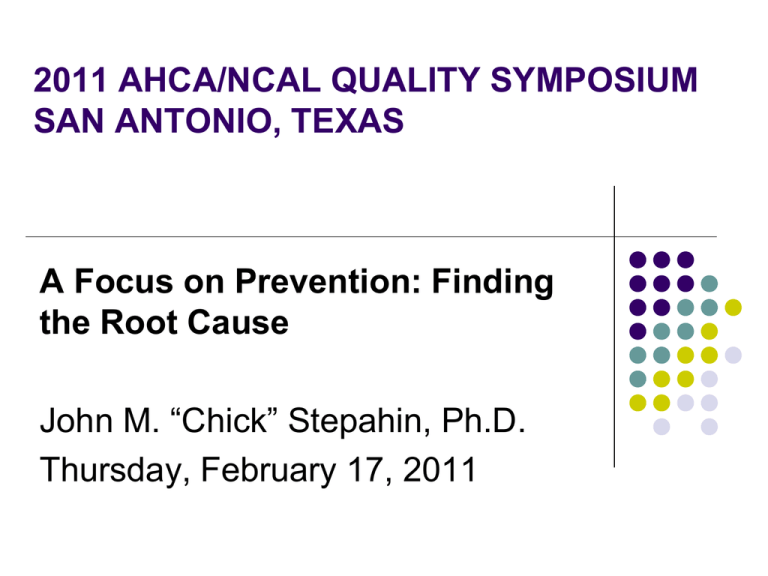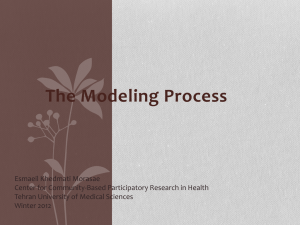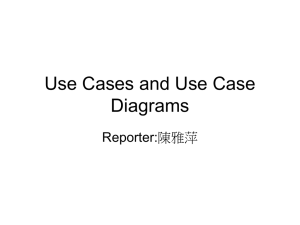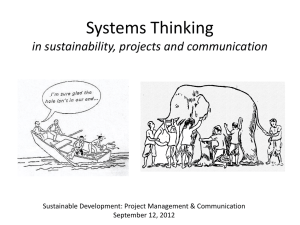2011 ahca/ncal quality symposium san antonio, texas
advertisement

2011 AHCA/NCAL QUALITY SYMPOSIUM SAN ANTONIO, TEXAS A Focus on Prevention: Finding the Root Cause John M. “Chick” Stepahin, Ph.D. Thursday, February 17, 2011 If you think the effort involved in quality improvement is not worth it, consider the cost of failure… Do it right the first time Zero defects Quality circles Statistical process control Professional results in daily efforts (PRIDE) Total quality management Kaizen Root cause analysis can be a powerful tool to help determine current obstacles to improvement, as well as identify those particular areas in which operational and process improvements might produce the greatest benefits. Reactive verses proactive The difference between QA and QI As the name implies, the root cause is the most basic reason a problem has (reactive) or could (proactive) occur… Root cause analysis techniques are most often used in the reactive mode…. …to uncover the reason(s) for problems that have already occurred Root cause analysis is only one of the many tools that should be used to support any quality improvement effort. Used in a “reactive mode,” it can prevent problems from recurring. Used in a “proactive mode,” it can examine current operations and help to identify areas and activities that can be improved. Definition: Root cause analysis is identifying the most basic reason for an undesirable condition or problem which, if eliminated or corrected, would have prevented it (the condition or problem) from existing or occurring. Most management texts agree that the normal management functions include: Planning Organizing Directing Controlling Plan Control Prevention Direct Organize There are many root cause analysis techniques….. …the good news is that almost any of them could/should work for almost any problem. Problem Nature Change Analysis Barrier Analysis Events and Causal Factors Analysis Tree Diagrams Organizational Good Best ____ Better Activity or Process Good Best Good Better Reorganization Best Good ____ Better New or Changed Activity Best Better ____ Good Personnel Good Best Better ____ Accident or Incident Good Better Best Good RCA Methods Less Structured approaches: Intuition Networking Experienced More Structured approaches: PERT, CPM, or other time-event networks Flowcharts or process charts Process control charts Trend analysis Pareto diagrams Nominal group techniques Brainstorming Etc. Scientific Process and Root Cause Analysis: Defining the problem Formulating Hypotheses Gathering appropriate data Evaluating potential solutions Objectively test and revise the solutions Develop a final list of potential solutions Overall System Continual Improvement Customer Expectations Problem Reporting Root Cause Analysis Fault Correction Performance Based Assessment Project/Process Management Trend Analysis RCA Techniques… Change Analysis Barrier Analysis Events and Causal Factors Analysis Tree Diagrams Etc. Change Analysis… …is an analytical technique which applies a systematic approach to problem solving by examining the effects of change. Change analysis may be performed in a reactive mode by analyzing unwanted events or problems, or in a proactive mode by identifying the potential effects of changes before they are implemented. Change analysis is perhaps the simplest of all the formal root cause analysis techniques and that most likely to be influenced by subjectivity or bias. Barrier analysis…. …the focus is on the barriers or safeguards that should have prevented or mitigated the unwanted event or problem. Barrier analysis normally is used in a reactive mode to solve surfaced problems or investigate events. Barrier analysis also can help to identify missing safeguards, those that might have prevented the problem if they had been in place. Events and Causal Factors Analysis… …provides a detailed analysis of the event sequence and associated causes or conditions. Events and causal factors charting is a very effective tool for analyzing “why” an event happened. Events and causal factors analyses often are used in conjunction with other root cause analysis techniques, particularly change and barrier analysis. Tree Diagrams… …are graphical displays of an event which logically describes each of the event’s contributing factors. Tree diagrams are extremely useful in helping visualize and analyze more complex systems or problem situations. When used reactively to investigate accidents and events, they are called fault or root cause trees. When used proactively to systematically plan and organize requirements for organizations, programs and projects, or future improvements, they are called positive trees. Other structured root cause analysis techniques: Management Oversight and Risk Tree Analysis (MORT) Human performance evaluation systems Cause and effect (fishbone) diagrams Others The quality journey and your destination… There are different levels at which organizations might presently be operating. Where are you? 1st level - finding and correcting of problems, with many being washed downstream. 2nd level – finding and fixing problems in such a manner they do not recur. 3rd level – the organization seeks to prevent problems or faults – they do not let them occur. Root cause analysis is only one piece of the puzzle in your quality journey. Although root case analysis is a vital element of any quality and productivity program, it is most effective when used in conjunction with the other elements. Root Cause Analysis case study application 2011 AHCA/NCAL Quality Symposium: Inspiring Excellence in Long Term Care I hope our session today reinforced your dedication to striving for excellence and provided you another tool and insight for your quality journey! John M. Stepahin chick@stepahin.com 903.238.4463











